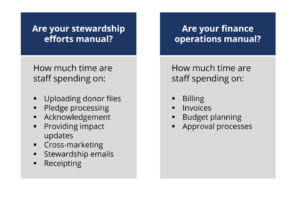Nonprofit leaders, I know you’re exhausted. It took everything you had to get your organization through the pandemic. You’re still facing a slew of competing priorities and high employee turnover. It may be tempting to revert to the old ways, but we’re in a new world:
Hybrid work has given us flexibility, but also the constant threat of employee burnout. After 2+ years of living their lives online, donors are increasingly tech savvy. They expect frictionless interfaces and personalized, engaging experiences. Add to that constantly shifting demographics and wealth distribution, and you have a lot to catch up on. It’s time to get out of survival mode and make the updates necessary for your nonprofit to thrive.
What’s the first thing you need to initiate smart change? Time. Time to assess, investigate options, and plan. Jeez. Wouldn’t you know? Time is the one thing nobody has. That’s why Step #1 of my modernization plan is to find you and your team some time. Then, you can devote that newfound time to modernizing the most critical parts of your operation: workforce development and stakeholder engagement. There’s so much to do, so let’s get started!
“It’s time to get out of survival mode and make the updates necessary for your nonprofit to thrive.”
Delegate Busywork to Bots
I know automation is on your radar. You’ve probably even heard about robotic process automation. Software-based digital assistants hang out on your desktop and do your mindless, data entry/manipulation tasks. But maybe you’ve steered clear, assuming you don’t have the IT budget to work such miracles.
Here’s the thing: Automation has changed a lot over the last few years. There are now out-of-the-box, low code/no code products anyone can learn. Bob in Accounting can string together a few lines of prebuilt code (drag-and-drop style) to automate a process he does every day, like matching pledges to payments. The learning curve is shallow, and the value gained is real. You can do this, so now you need to ask yourself:
Are my internal operations propelling my mission work or throttling it?
Take a look at your manual processes. Which ones are high-volume, rules-driven and repeatable? Which ones are the biggest time sucks? Here are some likely suspects:

Start by automating the tasks currently eating up the most staff time. Even if you feel like you’re just shaving seconds, it all adds up. With a little process reengineering, we’ve seen clients save well over 100 hours automating just one task. And let’s be honest: the bots are better at data entry and manipulation than we are anyway. They’re faster and more accurate. Let the computers crunch the numbers; save human brains for creativity, innovation, and building relationships.
Empower & Engage Employees (But Not Too Much)
Digital assistants (or bots) give your employees the gift of time. Data intelligence empowers them to use that time wisely. Data intelligence is really just taking all that data you’ve been stockpiling in your CRM forever and turning it into useful information that yields insights. Predictive analytics takes it a step further, applying data science to determine what might happen in the future.
We know individual donors make up the vast majority of nonprofit giving. Unfortunately, there’s a lot of churn in that pool. “The average non-profit will lose over 50% of its individual donors each year.” Predictive analytics is critical in determining which prospects are most likely to donate. It’s the tool your people need to focus their time and energy on high-potential givers in an ever-changing sea of prospects.
Data intelligence helps employees work smarter. It also powers cool new tools that tell you when they are working too much. Real-time wellbeing monitoring captures data like how often an employee’s focus time is interrupted, how much they’re emailing afterhours, and their number of sick days taken recently. These are all red flags that could indicate impending burnout. Modern nonprofits use their data to determine which work to do (and which to delegate to the bots), how to do it, and when to say when.
Design a Dynamic Employee Experience
You’ve automated the busywork. You’ve harnessed your data so the humans can work smarter. The team is happy, healthy, and engaged in purposeful work. Now you have the capacity to think through how best to modernize your nonprofit workplace.
I recommend you start with designing your employee experience. Why? Because your people are your most important asset, of course. When you invest in developing their skills, talents, and creativity, it always pays off. Maximum ROI.
First, design a system that allows new hires to onboard quickly and gain expertise continuously. Train and enable your people through learning management tools, collaboration, and knowledge management. Your training curricula shouldn’t live in a binder or in someone’s head. Turnover is high and the first 30 days are critical. Information should always be accessible, engaging, and easily updated/expanded. And your job isn’t done when the newbies are up to speed. Build a culture of lifelong learning and systems for sharing knowledge.
Share Compelling Stories Through Modern Channels
Your potential donors are getting younger all the time. Giving USA says, over the next 20 years, an estimated $30 – $70 trillion in wealth will be transferred from baby boomers to their heirs, and millennials are living in a digital world with expendable income. These younger donors are demanding a different philanthropic engagement level. They don’t want to just sign checks; they want to be part of your story.
Mobile integration is a must for the modern nonprofit, but it’s also a bare minimum. Expand your team’s reach and energize potential donors by using modern technology tools for storytelling and engagement. Get active across social media channels with different types of content: video, polls, podcasts, crowdfunding, even virtual reality. You may think of it as still far-off sci-fi, but VR is mainstream these days in some gaming and professional communities. And you don’t want to discount those gamers. Charity Navigator reports gamer live-streaming platform Twitch raised $83 million for charity in 2020. Everybody wants to do good, and gamifying the process brings in the young and the competitive.
Do You Have the Foundational Tech Stack You Need?
You need a point of leverage to build efficiencies and thrive in the current working space for nonprofits. That fulcrum is technology, implemented properly. As you design more efficient ways to work, invest in your employees, and engage new donors, a tech wish list will naturally emerge. If you have the right foundational technology stack, you’ll be amazed by how much you can do with what you have. It just takes a little optimization and a few standard add-ons.
If you’re sensing the need for a complete tech overhaul, try not to panic. A good technology partner can walk you through it at a pace that works for you and your budget. The focus of any tech project should always be on growing your people, engaging your donors, and building the momentum you need to drive your mission forward.
About Molly
 Even as a kid growing up here in Maryland, Molly Boncaro was mission-driven, and she wanted the answers to life’s big questions. Her parents weren’t thrilled with her degree in theology, but it launched her into a career that balances doing good with doing well. Molly spent almost 20 years with United Way. First, learning every aspect of nonprofit operation in the Central Maryland chapter, and later, leading the design and implementation of a modern philanthropy experience platform for United Way Worldwide.
Even as a kid growing up here in Maryland, Molly Boncaro was mission-driven, and she wanted the answers to life’s big questions. Her parents weren’t thrilled with her degree in theology, but it launched her into a career that balances doing good with doing well. Molly spent almost 20 years with United Way. First, learning every aspect of nonprofit operation in the Central Maryland chapter, and later, leading the design and implementation of a modern philanthropy experience platform for United Way Worldwide.
Molly has a passion for leveraging tech to propel mission work. Now, as senior business process analyst for Mind Over Machines, she’s loving the diversity of clients and the opportunity it affords to learn about and move lots of nonprofits forward. “When I improve an organization’s information architecture or design a smarter process, I’m making it easier for people to make a difference in their communities. Now that’s job satisfaction.”
When she’s not helping people make the world a better place, Molly is honing her project management skills in the kitchen. She loves to cook, host dinner parties, and watch her two boys build their own PCs as they follow in mom’s techie footsteps.










